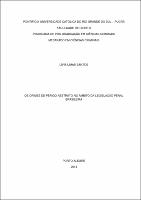| Share record |


|
Please use this identifier to cite or link to this item:
https://tede2.pucrs.br/tede2/handle/tede/4973| Document type: | Dissertação |
| Title: | Os crimes de perigo abstrato no âmbito da legislação penal brasileira |
| Author: | Santos, Lívia Limas  |
| Advisor: | D'avila, Fabio Roberto |
| Abstract (native): | O direito penal moderno, no limiar da sociedade de risco, busca cada vez mais o equilíbrio entre a proteção de bens jurídicos e sua função garantidora da sociedade, bem como o respeito entre os direitos e garantias fundamentais do cidadão. Não há sociedade sem crime e não há sociedade justa e pacífica sem as devidas sanções para estes crimes para que consigamos viver em paz e harmonia. Dessa feita, o direito penal é legítimo para intervir na esfera da tutela dos bens jurídicos dos cidadãos, através da sua função pacificadora, quando o mal causado por ele é menor que o mal que o agente causa à sociedade. A emergência para a proteção de certos bens jurídicos nos quais o dano causado é insustentável para a vítima e para a sociedade como um todo, requer uma proteção especial do direito penal, uma proteção antecipada, para que esse dano não se concretize e o bem jurídico permaneça num raio de segurança. Através da figura dos delitos de perigo abstrato, é possível a proteção dos bens jurídico-penais mais importantes a vida, a integridade física, o patrimônio, a paz social-, antes da sua nadificação pelo cometimento do delito. Frente a essa realidade fática é que neste trabalho trataremos dos crimes de perigo abstrato, desenvolvendo seus elementos principiológicos e teóricos, estrutura elementar e sua aplicação na legislação penal brasileira. |
| Abstract (english): | Modern criminal law, on the threshold of risk society, seeks more and more for a balance between protection of legal assets, the protective function of society it has as well as the respect between citizen s fundamental rights and guarantees. There is no society without crime and no just and pacific society without the necessary sanctions for these crimes so that living in peace and harmony is possible. Thus, criminal law is legitimate to intervene on the grounds of citizens legal assets guardianship, through its peaceful function, when the harm caused by it is smaller than the agent s harm to society. The emergency for certain legal assets protection, in which the harm caused is unbearable to the victim and to society as a whole, requires a special protection provided by criminal law, such as an anticipated one, so this harm does not come to be and the legal assets remains on a realm of security. By using the image of crimes of abstract danger, the protection of the most important legal assets life, physical integrity, heritage, social peace -, before its annulment through the act of crime, becomes possible. Faced with this juridical reality, crimes of abstract danger will be discussed and analysed, by developing its theoretical and related to principles elements, elementary structure and its application in Brazilian criminal legislation. |
| Keywords: | DIREITO DIREITO PENAL CRIMINOLOGIA TUTELA ANTECIPADA DIREITOS FUNDAMENTAIS CRIME (DIREITO PENAL) BENS JURÍDICOS |
| CNPQ Knowledge Areas: | CNPQ::CIENCIAS SOCIAIS APLICADAS::DIREITO |
| Language: | por |
| Country: | BR |
| Publisher: | Pontifícia Universidade Católica do Rio Grande do Sul |
| Institution Acronym: | PUCRS |
| Department: | Faculdade de Direito |
| Program: | Programa de Pós-Graduação em Ciências Criminais |
| Citation: | SANTOS, Lívia Limas. Os crimes de perigo abstrato no âmbito da legislação penal brasileira. 2014. 16 f. Dissertação (Mestrado em Ciências Criminais) - Pontifícia Universidade Católica do Rio Grande do Sul, Porto Alegre, 2014. |
| Access type: | Acesso Aberto |
| URI: | http://tede2.pucrs.br/tede2/handle/tede/4973 |
| Issue Date: | 8-Dec-2014 |
| Appears in Collections: | Programa de Pós-Graduação em Ciências Criminais |
Files in This Item:
| File | Description | Size | Format | |
|---|---|---|---|---|
| 464311.pdf | Texto Parcial | 413.08 kB | Adobe PDF |  Download/Open Preview |
Items in DSpace are protected by copyright, with all rights reserved, unless otherwise indicated.




